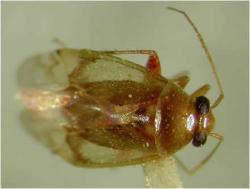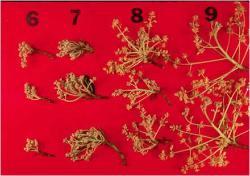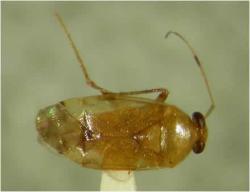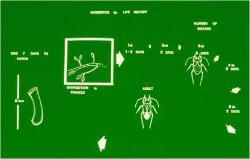Tropical Entomology - Avocado Mirids
Daghbertus fasciatus, D. olivaceous (Hemiptera : Miridae)
-
Description

Adult of an avocado mirid, Dagbertus fasciatusA number of species of small sucking insects known as mirids feed and insert their eggs on opening buds, leaves, flowers and small fruit. Mirids are injurious and widespread insect pests of avocado and cause diverse damage in some producer areas. Attacks seem to especially affect flowers and recently set fruit causing them to drop. Wounds on fruit may serve as a point of entry for decay organisms. These insects are comparatively small, and their nymphs can pass through several instars and increase in size. Color patterns change from a variety of green and brown. During the late 70s in Florida, USA, populations of mirids began to appear annually on avocado blossoms in numbers great enough to cause concern. Preliminary surveys showed the following mirids to be associated at least occasionally, with avocado blossoms: Polymerus cruentatus, Taylorilygus apiacalis, Lygus lineolaris, Neurocolpus flavescens, Rhinacloa sp., Dagbertus fasciatus and D. olivaceous. Later, Baranowski and Glenn (unpubl.) observed that the only species feeding and breeding on avocado were Dagbertus fasciatus Reuter and D. olivaceous (Reuter). Dagbertus adults were also collected from mango, longan, lychee, black olive, Schinus terenbinthifolius, Parthenium sp. and sabal palmetto (Baranowski and Glenn, unpublished). Attacks to avocado seem to especially affect flowers and recently set fruit, causing them to drop.
-
Damage

Mirids are found in opened flowersPart of plant damaged: Flower and fruit
Damage to avocado fruit is caused within the first few weeks after fruit set. This leads to the development of protrusions on larger fruit which are only visible about a month after feeding. The lesions that occur on avocado fruit are in the form of ‘pimply’ elevations on the fruit surface (Du Toit et al., 1993). If surveys indicate that large populations of the avocado bug are present shortly after fruit set, chemical control should be applied immediately (Van den Berg et al., 1999). -
Life Cycle
These insects are green-brown, comparatively small at 1 cm in length. Dagbertus eggs held at 23°C hatch in 6-8 d, nymphs go through 5 stages before reaching the adult stage. Dagbertus can complete a single generation in as short a time as 14 d (Glenn and Baranowski, unpubl.)
-
Management

Adult of an avocado mirid, Dagbertus olivaceusMirids usually appear during bloom and early fruit setting stage. It is suggested that weeds and grass in and around the grove be mowed as closely as practicable in order to reduce harboring places for mirids. Mirid populations are most common from January through April, when avocado flowers are fully open. If excessive flower drop is observed and coincides with numbers higher than 30 mirids per panicle, chemical control might be warranted. Spray applications during flowering should be made in later afternoon to reduce losses of honey bees.
Chemical Control
Fact Sheets
-
References

Different life stages of development of avocado miridsCENDAÑA, S. M., GABRIEL, B.P., AND MAGAALLONA, E.D. 1984. Insect pests of fruit crops in the Phillippines. Department of Entomology, University of the Phillippines, Los Baños.
DU TOIT, W.J., STEYN, W.P., AND DE BEER, M.S. 1993. Occurrence of protrusions on avocado fruit and the causative agent. South African Avocado Growers’ Association Yearbook 16: 100-102.
VAN DEN BERG, M.A. DE VILLIERS, E.A., AND JOUBERT, P.H. 1999. Identification manual for avocado pests. Dynamic Ad, Nelspruit, 53 pp.

